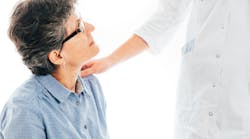The power of physical touch in your dental practice
Dr. Justin Short learned about the power of touch firsthand. His physician impressed him with his sincere display of caring, and Dr. Short wants to do the same with his patients. It's all about the "ol' two-pat."
Several years ago I was sick and visited my physician. I don’t remember exactly what brought me in for the visit, but I do remember one thing from my visit that day. Oddly enough it was how my doctor touched me—and no, not in a weird way!
When he was leaving the room and I was sitting on the table, he patted my knee and told me all would be okay. During that brief, one-second touch, I felt like he really cared and that yes, everything would be ok. I'm always looking for ways to increase my rapport with my patients. From that moment on I realized the importance of physical touch.
Once you understand the basics of reassuring, connecting, and (of course) appropriate physical touch, you can begin to effectively apply it. Touch is a simple yet very powerful and effective tool to use in building patient rapport. Physical touch stimulates the production of oxytocin, the “feel good” hormone. When you touch someone, the hormone is released, they feel good, and they associate that good feeling with you, their doctor. In turn they are more likely to like you as a person and trust you as their oral health-care provider.
RELATED READING:
Mouth problems lead to “authentic” interaction with dentist: Are you authentic?
7 simple ways to make your dental patients happy with you
5 ways for your dental practice to improve the patient experience through payment methods
The power of touch can be very influential. Countless studies have shown that waiters and waitresses who use casual physical touch consistently receive bigger tips than those who don’t. Store greeters who touch customers as they enter the store actually influence patrons to stay longer.
A study from the University of Philadelphia illustrated these theories further. In this study, they set up a phone booth with a coin left behind in the coin slot. When the phone user was approached by an actor who asked, “Hey, I think I left a coin. Did you find it?” 92% of individuals studied said no. They then performed this same sequence but with one slight variable: when the actors asked if the users had found the coin, they gave a light touch on the shoulder or elbow at the same time. In the sequence with the physical touch, the phone users said yes 88% of the time.
“…touching someone on the arm, hand, or shoulder for as little as 1/40 of a second is enough to create a human bond.” Forbes Magazine
I started using this idea of "touch" several years ago. Allow me to share the three most common ways I have incorporated physical touch into my practice to encourage my patients to know, like, and trust me more.
1. At the end of my hygiene exam—When I'm finished doing my exam and right as I'm sitting the patient up, I give my patient a quick, gentle "two-pat" as I call it, directly on the shoulder. At the same time, I'm usually saying, “It was good seeing you,” “I think you’re going to make it” (a bit tongue-in-cheek), or “Sorry I didn’t get to make your day.” The last one is if I have to deliver news that didn’t exactly have them jumping for joy.
2. While I am working on patient—Whether I’m doing a periodontal cleaning or placing a new CEREC crown, even if it seems the patient is doing fine, I'll stop just for a moment, put my hand on the person's shoulder for a split second, and ask them either “How are you doing?” “Are you doing ok?” or “So are we having fun yet?” What I'm really saying is, "Hey, I care for you, and I want you to know that.”
3. When a patient is checking out—This is the most common use of physical touch for me personally. Perhaps I wasn’t in the room when the assistant excused the patient, or I didn’t need to do a hygiene check. If I have time and I see the patient standing at the checkout desk, I'll walk up beside the person, give him or her the ol’ "two-pat" on the shoulder and ask, “How are you feeling?” “Let me know if you need anything,” or “Did she work you over?” ("She" is the hygienist, and again, this is in a joking manner that patients find personable.) This interaction lets patients know that I care about not only them as patients, but them as people, and that they can have a positive, friendly, yet of course professional relationship with me and my practice.
It is nearly impossible for me to quantify this "touch" technique in terms of increased production or patient rapport. That being said, I know there is something magical here, and I know it is a simple, subtle, and important skill to have in your rapport-building repertoire. This is one of many techniques we use in our practices to build our "tribe of raving fans." We have over 100 five-star Google reviews, the most in our area by far. Although I can't attribute our success to one particular tool we use, I know the use of physical touch is an integral piece of the puzzle.
A simple touch on the shoulder, elbow, or knee could be the difference between a failing, average, or successful practice. It’s brought me great success so far, and I encourage you to give it a try if you're not already using it in your daily practice. If you want to not only attract new, quality patients, but also increase case acceptance and foster more positive, trusting relationships between you and your patients, just remember the power of the ol’ "two-pat."
For the most current dental headlines, click here.
For more advice on building and growing a successful dental practice, get my free guide, 5 Things You DON’T Need…To Have a Wildly Successful Dental Practice.

